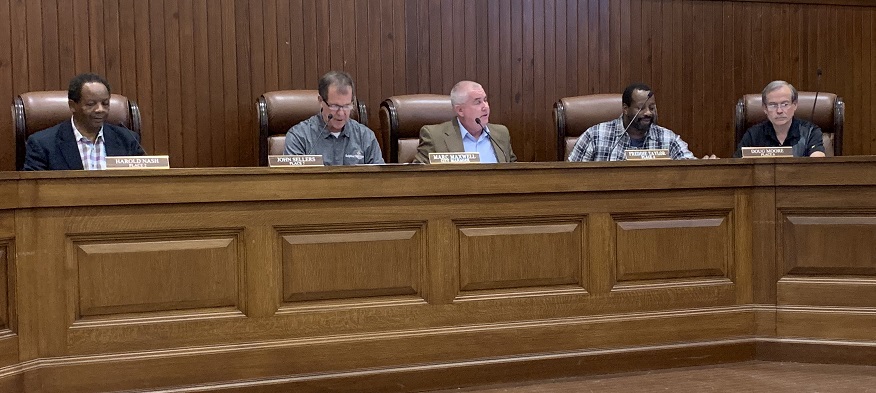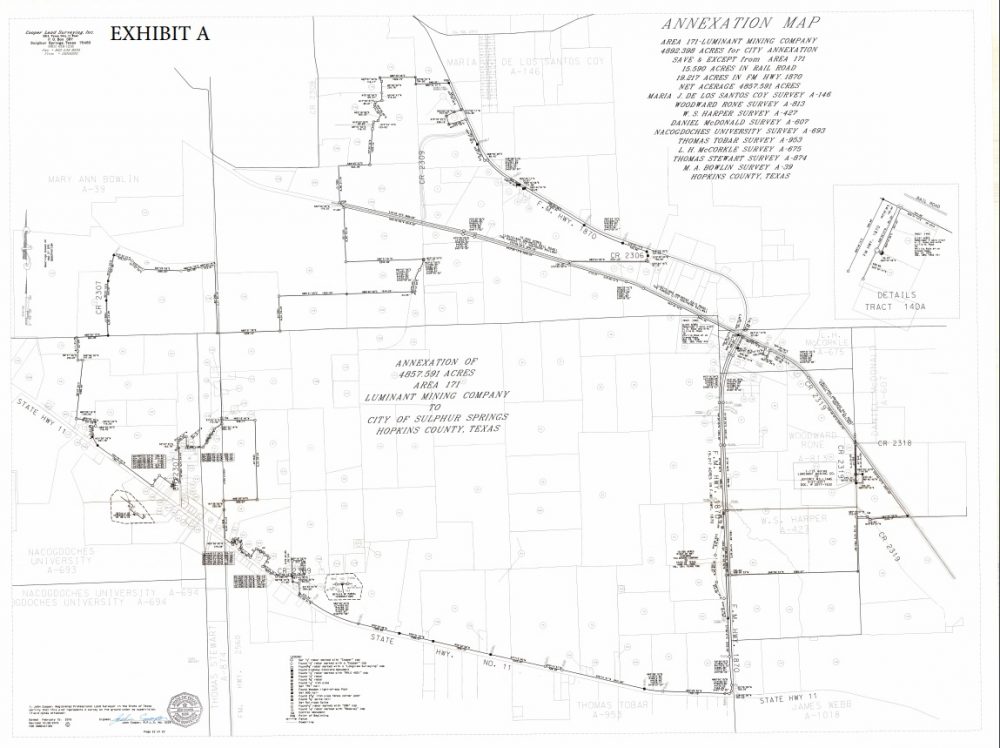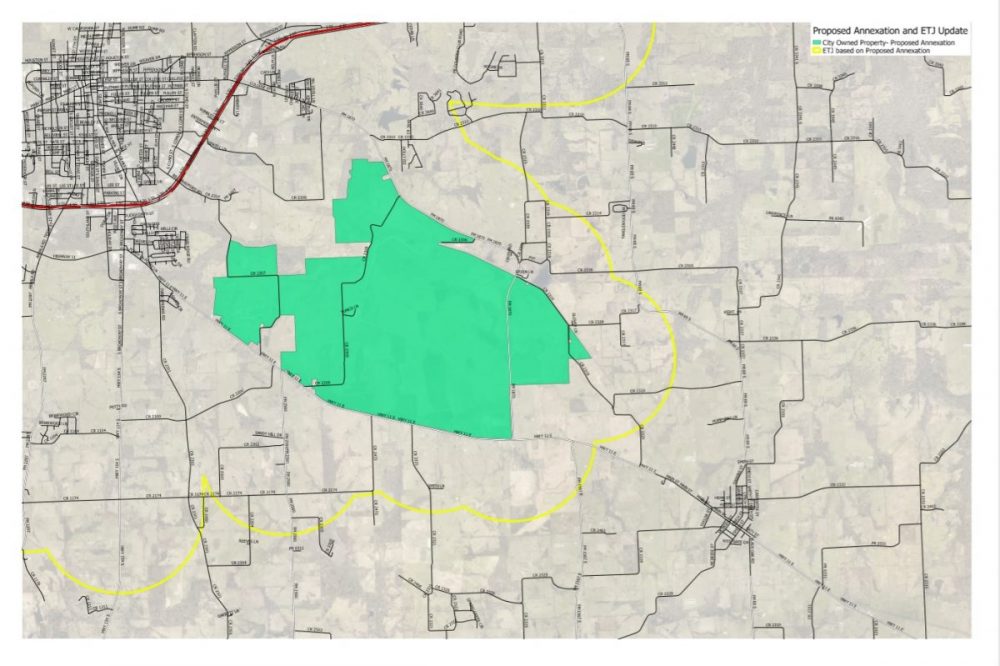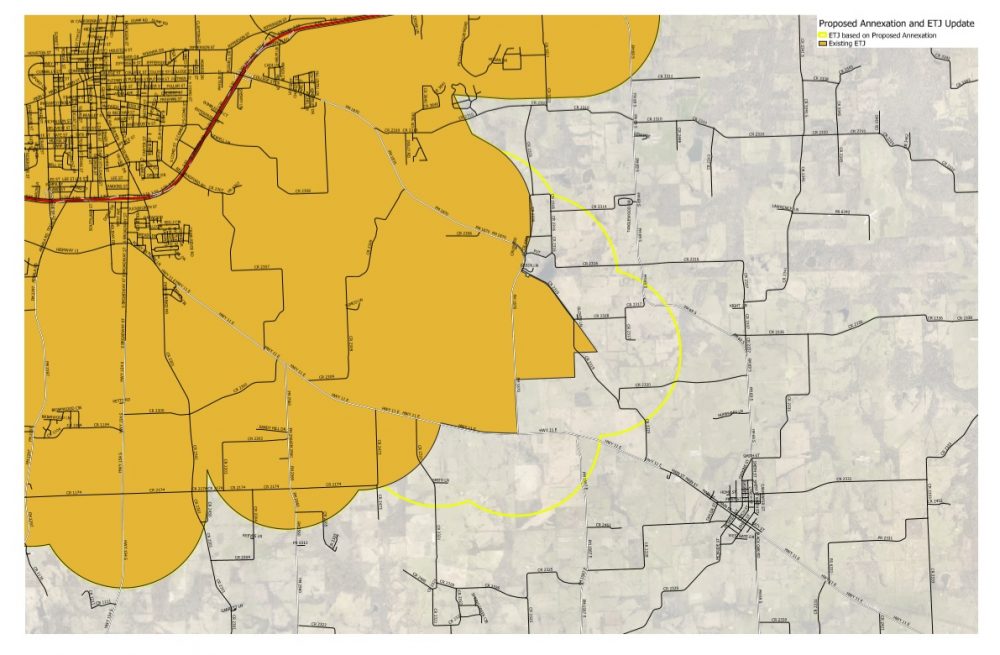Reclamation Responsibility, Land Leases, ETJ Boundaries, Maintenance Discussed During First Hearing On Annex

City residents who have questions regarding the old Thermo Mine/ Luminant property that is now owned by the city are encouraged to attend Thursday’s special city council meeting.
The 6 p.m. session Jan. 9 is designated specifially as a public hearing for community members to voice any questions, comments or concerns they may have regarding the property and the proposed annexation of that property into the city.
At least three community members and a local businessman approached the council during the first public hearing at 5:30 p.m. Tuesday regarding the annexation of the old Thermo mine property.
Concerns focused on status and extent of reclamation and who is responsible for it, land lease agreements individuals had with Luminant, extent of annexation and extra jurisdictional territory and what that means for nearby residents or property owners, and maintenance of land bordering the old mine property.
Reclamation Responsibility

Tim Kelty asked what the situation is with the land that needs to be reclaimed, how much of the land is like that, and what part of it will be the city’d responsibility.
Sulphur Springs City Manager Marc Maxwell noted that Area H on the property map is the last area that’s yet to be reclaimed at the mine. Once the former owner’s plan is approved by the Railroad Commission, it will take a few months to do the work on the reclamation.
“Then, waiting begins. There will be a five year period where they monitor the land, then they go into an extended period of responsibility for two, three, four years and continue to monitor it. I expect as a part of that they will have to reshape the pond and they will have to seal the pond because it’s exposed to a coal seam at the bottom. They will probably reduce the height of the mountain and grade it out somewhat to what amount, we just don’t know yet, because they don’t have their approved plan yet from the Railroad Commission,” Maxwell said.
Kelty asked how many of the total acres are not in any of the reclamations.
“There are just short of 5,000 acres total, and 400 that have yet to be reclaimed. Although other property has been reclaimed and is in the extended period of monitoring. The city has about 2,500 acres that are free and clear,” Maxwell said.
Councilman Doug Moore noted Luminant is bonded, which Maxwell noted means that the project is covered with funding to complete the process. Areas that have completed the reclamation process to state’s satisfaction are call “off-bond.”
City Attorney Jim McLeroy said the former Luminant mine owners are 100 percent responsible for all reclamation. What the city is receiving is reclaimed and ready for whatever future use the city chooses.
“We have no financial obligations, no financial risk, as far as those environmental concerns for the fact that this used to be a mine. When it comes off bond, when it’s completely through the reclamation process it will look like land there on the east side of that development, which looks like that pasture land across the street, beautiful country and it looks great. It is fully reclaimed. We’re not going to have do anything to it to complete that,” McLeroy said.
“So basically, you’re going to receive 25 hundred acres that we can do whatever we want with, no strings attached or anything, other than what the city puts on it?” Kelty asked.
McLeroy affirmed that to be true. He noted the city owns the other 2,500 acres and will receive it in the future once the property is fully reclaimed and off bond. The city granted the company an easement so they have the right to go in and do the work required to finish their legal obligation for the property.
Andy Smith asked for verification that the city is “free and clear” of responsibility for any “clean up” required and the company responsible is financially solvent to ensure all required work is completed.
McLeroy said the bonds they have posted by the previous owner are financial guaranties that there’s a source of funding to complete their obligation.
Land leases
As promised, Jean Barnes’ concern regarding land she has been leasing from Luminant for the last 14-15 years was addressed during the regular city council meeting which followed at 7 p.m. Jan. 7.
The City Council, during their regular Tuesday night, agreed to renew land lease agreements for use of certain portions of the old Thermo Mine/Luminant property at the same rate for 1 year. The lease contracts would be the same, except each lease would have to be renew pending council approval each year.
Three of the four lease agreements were for grazing cattle and hay production: Jonah Massey 82-acre lease on the southwest corner of the property, Jean Barnes 4.7-acre agriculture lease and Legend Cattle Company has a 959-acre lease in the middle. Hopkins County also has a lease for $2 a year for use of a sand pit, Maxwell noted.
The four agreements are expected to generate about $17,900 in revenue annually for the city. Maxwell was given authority to sign documents for those leases.
Barnes said a one year-lease at the same price was sounded “very good” to her and what she was looking for.
ETJ, Boundaries

A Lynda McKay, who owns property near the mine, expressed concern regarding the identified extra territorial jurisdiction for the proposed annex and what that will mean for people with property within it.
Community Development Director Tory Niewiadomski explained that he ETJ simply means if someone were to create a housing develop within a mile of the property, they would have to meet the city’s subdivision requirements. The city has no planning or zoning jurisdiction in the area; they would only have to meet city standards when subdividing property.
Irene Hanson, who owns property on State Highway 11 east, asked if her property would be annexed into the city as well. She has a “small cut out” of property in that area, and was concerned she’d have to pay city taxes.
“You are not going to be annexed into the city for two reasons,” Maxwell said. “We cannot legally annex you unless you ask us to.”
“Unless you want to be in the city in the future, we don’t have the power to annex you. If you want to be in the city, you have the right to petition to be in the city and the council will have the right to decide if they want to accept you into the city. The reason we can annex it is because we own it,” McLeroy said.
In order to annex the property into the city, hearings must be held for community input, then it will be presented to the City Council for approval for that property only. The annexation does not include any other property around the mine or between the mine and the city.
Maxwell said also the city is “not of a frame of to go out and annex places, because then we have to provide services. Typically, the property taxes generated from the annexation are not sufficient to pay for the services. So, it’s been our frame of mind, and certainly mine for decades now.”

Maintenance
Irene Hanson too expressed concern for condition of old mine property that borders her land. She said they’ve had to “shred around” and mowed along the back property line due to the weeds for years, and wanted to know if the city would be providing routine maintenance of that nature.
“I wouldn’t expect us to get out there with shredders and mowers,” Maxwell said.
Irene Hanson asked if the city would be fending off the old mine property.
“We have no plans to fence,” Maxwell said.
McLeroy asked if the land is part of the mine property that’s been leased for agricultural purposes.
“Nobody has done anything to maintain this for several years. There are fences, but they’re old, old, so I’m wondering where does our responsibility lay?” Hanson asked.
Maxwell noted along the property line would be the city’s responsibility. He said the reclamation process means they move dirt, plant trees and nativegrasses. That is the former owner’s respnsibilty. The state has been monitoring that process.
Hanson said the land had previously used for hay, and was maintained during that time. However, it hasn’t been used for that purpose in five years. During that time, the weeds have become terribly overgrown.
Maxwell said if the neighboring property owner is interested in cutting it for hay, he’d welcome them to come talk to him to work out an agreement.
“Well, I wish somebody would because it looks terrible, and it’s a fire hazard for one thing,” she said, adding that hogs have run rampant in the area.
Hanson’s son Christopher Hanson, who lives on her property as well, said the hogs and coyotes come up close in the yard at night. They’ve shot several of them.
“If that is a problem, we’re going to have to figure out how to address it,” Maxwell said.
Christopher Hanson said a pond on the old mine property is also a problem. It’s become more of a swamp, resulting in an extremely bad mosquito and pesk problem. Last year, he said they killed 36 snakes. The condition of the adjoining mine property is a fire hazard, he added. He said when the former owner’s were contacted, they claimed they were unable to do anything about the issues because of the property’s proximity to the Hanson property.
Maxwell encouraged the Hansons to visit with him next week to identify their property on a map in proximity to the city property and discuss the issues.







